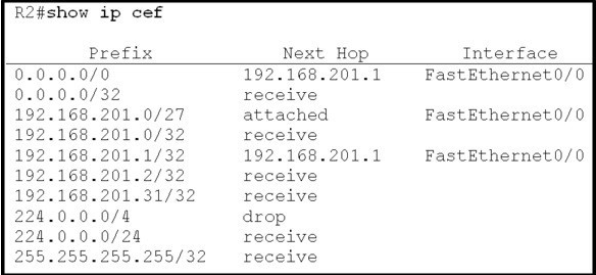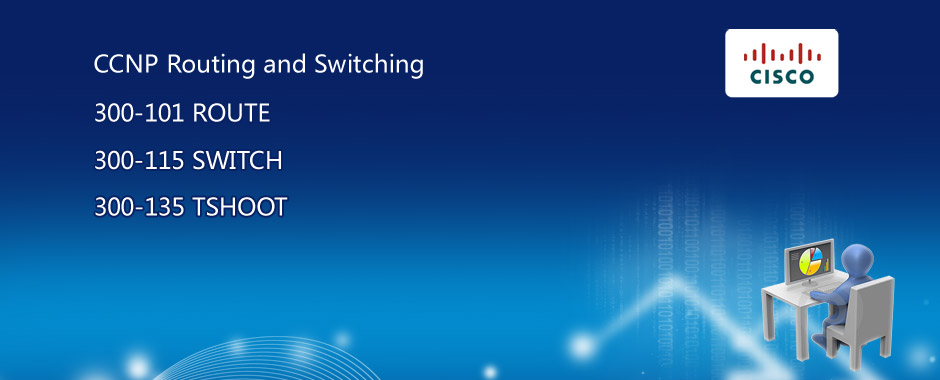[2017-Mar-NEW] Download Free 300-101 Dumps For Cisco Exam in First Attempt
Cisco has created new certifications that 300-101 dumps route pdf will help you work toward the cov-eted CCIE, as well as aid prospective employers in measuring skill levels. Before these new certifications were created, you took only one test and were then faced with the lab, which made it difficult to succeed. With these new certifications, there is an incremental path toward preparing for that almighty lab; Cisco has opened doors that few were allowed through before. So, what are these new certifications, and how do they help you get your CCIE?
Cisco Network Support Certifications
Exam Code: 300-101
Exam Name: Implementing Cisco IP Routing (ROUTE v2.0)
Updated: Feb 23, 2017
Q&As: 192
Associated Certification: Cisco Certified Network Professional Routing and Switching Certification
Number of Question: 45-65 Questions
Exam Technology: Cisco Networking Technology
Pre-Requisites: CCNA Routing and Switching or any CCIE Certification Certification
Exam Languages: English
Format: Single and Multiple Choice
Exam Information:http://www.pass4itsure.com/300-101.html
All information collected from Cisco Official Site:http://www.cisco.com/c/en/us/training-events/training-certifications/exams/current-list/route2.html
Note: Some Cisco documentation states that VRF is an acronym for Virtual Routing and
Forwarding, while other Cisco documentation states that VRF is an acronym for VPN Routing/Forwarding because of its common use in Virtual Private Networks VPN.
2017 Cisco 300-101 exam dumps (All 70 Q&As) from Pass4itsure:
300-101 dumps QUESTION 1
Refer to the exhibit

Based on this FIB table, which statement is correct?
A. There is no default gateway.
B. The IP address of the router on FastEthernet is 209.168.201.1.
C. The gateway of last resort is 192.168.201.1.
D. The router will listen for all multicast traffic.
Correct Answer: C
Explanation
Explanation/Reference:
Explanation:
The 0.0.0.0/0 route is the default route and is listed as the first CEF entry. Here we see the next hop for this default route lists 192.168.201.1 as the default router
(gateway of last resort).
300-101 dumps QUESTION 2
Refer to the exhibit.

A network administrator checks this adjacency table on a router. What is a possible cause for the incomplete marking?
A. incomplete ARP information
B. incorrect ACL
C. dynamic routing protocol failure
D. serial link congestion
Correct Answer: A
Explanation
Explanation/Reference:
Explanation:
To display information about the Cisco Express Forwarding adjacency table or the hardware Layer 3-switching adjacency table, use the show adjacency
command.
Reasons for Incomplete Adjacencies
There are two known reasons for an incomplete adjacency:
The router cannot use ARP successfully for the next-hop interface.
After a clear ip arp or a clear adjacency command, the router marks the adjacency as incomplete. Then it fails to clear the entry.
In an MPLS environment, IP CEF should be enabeled for Label Switching. Interface level command ip route-cache cef
No ARP Entry
When CEF cannot locate a valid adjacency for a destination prefix, it punts the packets to the CPU for ARP resolution and, in turn, for completion of the adjacency.
300-101 dumps QUESTION 3
A network engineer notices that transmission rates of senders of TCP traffic sharply increase and decrease simultaneously during periods of congestion. Which
condition causes this?
A. global synchronization
B. tail drop
C. random early detection
D. queue management algorithm
Correct Answer: A
Explanation:
TCP global synchronization in computer networks can happen to TCP/IP flows during periods of congestion because each sender will reduce their transmission
rate at the same time when packet loss occurs.
Routers on the Internet normally have packet queues, to allow them to hold packets when the network is busy, rather than discarding them.
Because routers have limited resources, the size of these queues is also limited. The simplest technique to limit queue size is known as tail drop. The queue is
allowed to fill to its maximum size, and then any new packets are simply discarded, until there is space in the queue again. This causes problems when used on
TCP/IP routers handling multiple TCP streams, especially when bursty traffic is present. While the network is stable, the queue is constantly full, and there are no
problems except that the full queue results in high latency. However, the introduction of a sudden burst of traffic may cause large numbers of established, steady
streams to lose packets simultaneously.
300-101 dumps QUESTION 4
Which three problems result from application mixing of UDP and TCP streams within a network with no QoS? (Choose three.)
A. starvation
B. jitter
C. latency
D. windowing
E. lower throughput
Correct Answer: ACE
Explanation
Explanation/Reference:
Explanation:
It is a general best practice not to mix TCP-based traffic with UDP-based traffic (especially streaming video) within a single service provider class due to the
behaviors of these protocols during periods of congestion. Specifically, TCP transmitters will throttle-back flows when drops have been detected. Although some
UDP applications have application-level windowing, flow control, and retransmission capabilities, most UDP transmitters are completely oblivious to drops and thus
never lower transmission rates due to dropping. When TCP flows are combined with UDP flows in a single service provider class and the class experiences
congestion, then TCP flows will continually lower their rates, potentially giving up their bandwidth to drop-oblivious UDP flows. This effect is called TCP-starvation/
UDP-dominance. This can increase latency and lower the overall throughput.
TCP-starvation/UDP-dominance likely occurs if (TCP-based) mission-critical data is assigned to the same service provider class as (UDP-based) streaming video
and the class experiences sustained congestion. Even if WRED is enabled on the service provider class, the same behavior would be observed, as WRED (for the
most part) only affects TCP-based flows. Granted, it is not always possible to separate TCP-based flows from UDP-based flows, but it is beneficial to be aware of
this behavior when making such application-mixing decisions.
300-101 dumps QUESTION 5
Which method allows IPv4 and IPv6 to work together without requiring both to be used for a single connection during the migration process?
A. dual-stack method
B. 6to4 tunneling
C. GRE tunneling
D. NAT-PT
Correct Answer: A
Explanation
Explanation/Reference:
Explanation:
Dual stack means that devices are able to run IPv4 and IPv6 in parallel. It allows hosts to simultaneously reach IPv4 and IPv6 content, so it offers a very flexible
coexistence strategy. For sessions that support IPv6, IPv6 is used on a dual stack endpoint. If both endpoints support IPv4 only, then IPv4 is used.
Benefits:
Native dual stack does not require any tunneling mechanisms on internal networks
Both IPv4 and IPv6 run independent of each other
Dual stack supports gradual migration of endpoints, networks, and applications.
Reference:
300-101 dumps QUESTION 6
Which statement about the use of tunneling to migrate to IPv6 is true?
A. Tunneling is less secure than dual stack or translation.
B. Tunneling is more difficult to configure than dual stack or translation.
C. Tunneling does not enable users of the new protocol to communicate with users of the old protocol without dual-stack hosts.
D. Tunneling destinations are manually determined by the IPv4 address in the low-order 32 bits of IPv4-compatible IPv6 addresses.
Correct Answer: C
Explanation
Explanation/Reference:
Explanation:
Using the tunneling option, organizations build an overlay network that tunnels one protocol over the other by encapsulating IPv6 packets within IPv4 packets and
IPv4 packets within IPv6 packets. The advantage of this approach is that the new protocol can work without disturbing the old protocol, thus providing connectivity
between users of the new protocol. Tunneling has two disadvantages, as discussed in RFC 6144:
Users of the new architecture cannot use the services of the underlying infrastructure.
Tunneling does not enable users of the new protocol to communicate with users of the old protocol without dual-stack hosts, which negates interoperability.
Reference:
300-101 dumps QUESTION 7
A network administrator executes the command clear ip route. Which two tables does this command clear and rebuild? (Choose two.)
A. IP routing
B. FIB
C. ARP cache
D. MAC address table
E. Cisco Express Forwarding table
F. topology table
Correct Answer: AB
Explanation
Explanation/Reference:
Explanation:
To clear one or more entries in the IP routing table, use the following commands in any mode:
Command Purpose
clear ip route {* |
Clears one or more routes from both the
{route |
unicast RIB and all the module FIBs. The
prefix/length}[next-hop route options are as follows:
interface]}
· *–All routes.
[vrf vrf-name]
Example:
· route–An individual IP route.
switch(config)# clear ip
· prefix/length–Any IP prefix.
route
10.2.2.2
· next-hop–The next-hop address
· interface–The interface to reach the
next-hop address.
The vrf-name can be any case-sensitive, alphanumeric string up to 32 characters.
Reference:
300-101 dumps QUESTION 8
Which switching method is used when entries are present in the output of the command show ip cache?
A. fast switching
B. process switching
C. Cisco Express Forwarding switching
D. cut-through packet switching
Correct Answer: A
Explanation
Explanation/Reference:
Explanation:
Fast switching allows higher throughput by switching a packet using a cache created by the initial packet sent to a particular destination. Destination addresses
are stored in the high-speed cache to expedite forwarding. Routers offer better packet-transfer performance when fast switching is enabled. Fast switching is
enabled by default on all interfaces that support fast switching.
To display the routing table cache used to fast switch IP traffic, use the “show ip cache” EXEC command.
Reference:
300-101 dumps QUESTION 9
Which two actions must you perform to enable and use window scaling on a router? (Choose two.)
A. Execute the command ip tcp window-size 65536.
B. Set window scaling to be used on the remote host.
C. Execute the command ip tcp queuemax.
D. Set TCP options to “enabled” on the remote host.
E. Execute the command ip tcp adjust-mss.
Correct Answer: AB
Explanation
Explanation/Reference:
Explanation:
The TCP Window Scaling feature adds support for the Window Scaling option in RFC 1323, TCP Extensions for High Performance . A larger window size is
recommended to improve TCP performance in network paths with large bandwidth-delay product characteristics that are called Long Fat Networks (LFNs). The
TCP Window Scaling enhancement provides that support. The window scaling extension in Cisco IOS software expands the definition of the TCP window to 32
bits and then uses a scale factor to carry this 32-bit value in the 16-bit window field of the TCP header. The window size can increase to a scale factor of 14.
Typical applications use a scale factor of 3 when deployed in LFNs.
The TCP Window Scaling feature complies with RFC 1323. The larger scalable window size will allow TCP to perform better over LFNs. Use the ip tcp windowsize command in global configuration mode to configure the TCP window size. In order for this to work, the remote host must also support this feature and its
window size must be increased. Reference:
CCNP ROUTE 300-101 Part 1.2 – General Network Challenges

When designing a new network or analyzing an existing network, the ability to determine how traffic flows through that network is a necessary skill. Traffic flow is determined both by the traffic type (unicast, multicast, broadcast, or anycast) and the network architecture type (point-to-point, broadcast, and nonbroadcast multiaccess).
We are offering learning material for 300-101 Implementing Cisco IP Routing (ROUTE v2.0) exam by considering the real Cisco 300-101 exam criteria. Our highly educated experts are devoting their duties to prepare most relevant 300-101 exam questions for you. Try our free demo version which indicates real CCDP/CCNP Routing and Switching/CCNP 300-101 dumps including exam time, types of questions and other necessary details. Our experts have made two types of learning material according to the need of 300-101 Implementing Cisco IP Routing (ROUTE v2.0) exam applicants. We are providing PDF format solved questions and answers and Practice test software 300-101 vce Implementing Cisco IP Routing (ROUTE v2.0) exam.
We provide free updates for 90 days from the date of purchasing. Pass4itsure also provides free technical support and live chat 24/7 for your facility. In order to keep our customers date secure, we uses unbreakable security protocols by McAfee and SSL 64-Bit.
We provide special discount and promotions for regular customers so keep visiting the http://www.pass4itsure.com/300-101.html
![[2017-NEW!]Validating Knowledge About Cisco 700-037 Vce and PDF in the Latest Version](https://www.collection4pdf.com/wp-content/themes/ribbon-lite/images/nothumb-related.png)